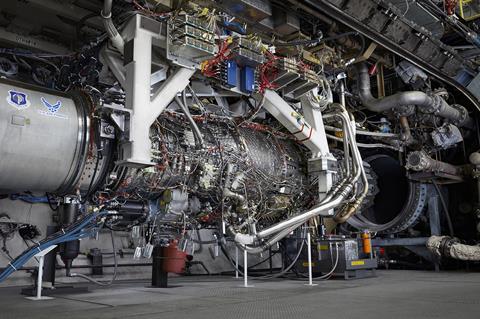[ad_1]
GE Aviation has wrapped up testing on its first XA100 prototype, an adaptive cycle engine.
An adaptive cycle engine is a novel turbine that can change air flow through three different air streams, depending on an aircraft’s need for efficiency or extra power. The US Air Force (USAF) has been funding development of the engine type since 2007.

Testing on the XA100 started in December 2020. The prototype showed performance and mechanical behaviour were consistent with pre-test predictions, says GE Aviation on 13 May. The engine met the USAF Adaptive Engine Transition Program (AETP) objectives, the company says.
“We were exceptionally pleased with how the engine performed throughout the test,” says David Tweedie, GE Edison Works’ general manager for advanced combat engines. “We’re looking forward to working with the Air Force and other stakeholders to identify the next steps toward bringing this revolutionary capability out of the test cell and into the hands of the warfighter.”
The USAF is interested in re-engining the Lockheed Martin F-35A stealth fighter with an adaptive engine to increase the aircraft’s 1,200nm (2,222km) range, which is viewed as too short for attacking targets within China. The fighter currently is powered by the Pratt & Whitney F135 turbine engine.
Adaptive engines work by changing the volume of air flow that bypasses the turbine core by opening a third stream when flying in cruise mode. This third flow – in addition to the core flow and bypass turbofan flow – increases the engine’s efficiency. Alternatively, in high-thrust mode the engine directs the majority of air through the engine’s core and bypass turbofan streams, delivering greater thrust for combat manoeuvring. The third flow also has a cooling effect, allowing the core to run hotter which further increases fuel efficiency.
GE Aviation claims an adaptive cycle engine could deliver to an aircraft a 50% improvement in loiter time, 35% increase in range, 25% reduction in fuel consumption, 10% increase in thrust and 60% more heat absorption. It is thought that additional cooling capacity could be useful for managing heat coming off directed energy weapons, such as lasers.
The XA100 was developed using ceramic matrix composites, polymer matrix composites and additive manufacturing, says GE Aviation. The company says it was able to learn a lot from its initial test regime.
“This was the most heavily instrumented engine test in both GE and US Air Force history,” Tweedie says. “We were able to obtain an immense amount of high-quality test data proving out the engine’s capabilities and demonstrating a good return on the Air Force’s investment.”
Assembly of the second prototype XA100 engine is underway, says GE Aviation. Testing on that engine planned to start later in 2021 and when finished would conclude the major deliverables of the AETP programme.
[ad_2]
Source link








